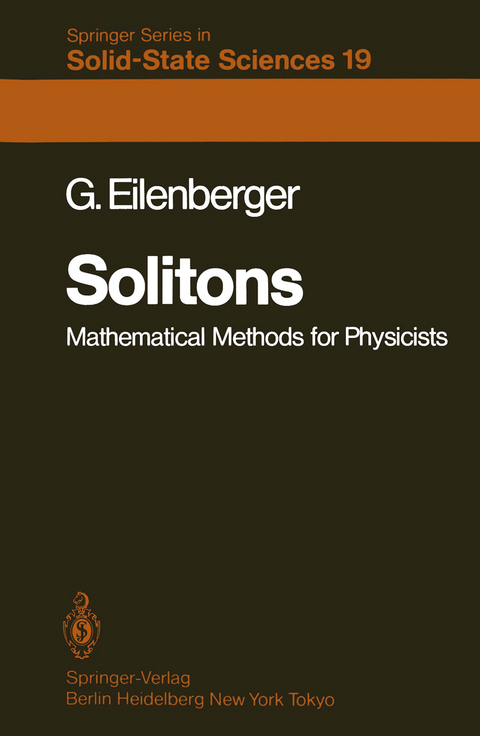
Solitons
Springer Berlin (Verlag)
978-3-540-10223-6 (ISBN)
Prof. Dr. Guido Eilenberger war nach dem Studium der Rechts- und Wirtschaftswissenschaften und einer Tätigkeit als wissenschaftlicher Mitarbeiter an der Universität München Lehrbeauftragter, Professor und Gastprofessor der Universität Innsbruck, der Kath. Universität Eichstätt und der TU Chemnitz. Von 1993 bis 2006 war er Inhaber des Lehrstuhls für Allgemeine Betriebswirtschafslehre, Bankbetriebslehre und Finanzwirtschaft der Universität Rostock und Vorstand des Instituts für Betriebswirtschaft sowie Direktor des Instituts für Bankwirtschaft an der Universität Rostock. Forschungsaufenthalte führten ihn in die USA, nach Hongkong und Singapur sowie an die europäischen Finanzzentren. Er ist Autor zahlreicher Lehrbücher. Seit 2006 ist Prof. Dr. Eilenberger Professor emeritus mit Aktivitäten bevorzugt im International Banking und International Finance.
1. Introduction.- 1.1 Why Study Solitons?.- 1.2 Basic Concepts Illustrated by Simple Examples.- 2. The Korteweg-de Vries Equation (KdV-Equation).- 2.1 The Physical Meaning of the KdV Equation.- 2.2 The KdV Equation as a Lagrangian Field Theory: Symmetries.- 2.3 Local Conservation Laws for the KdV System.- 2.4 Simple Solutions of the KdV Equation.- 3. The Inverse Scattering Transformation (IST) as Illustrated with the KdV.- 3.1 The Linear Eigenvalue Problem.- 3.2 Commutation Relations for (KdV)n.- 3.3 Inverse Scattering Theory of Gel'fand-Levitan-Marchenko.- 3.4 Application to the KdV Equation: N Soliton Solution.- 3.5 Squared-Function Systems, or: the Secret of the KdV Equation.- 3.6 Dynamics of the Scattering Data.- 3.7 Birth and Death of Solitons.- 4. Inverse Scattering Theory for Other Evolution Equations.- 4.1 Statement of the Problem.- 4.2 Inverse Scattering Theory for Equation (4.1.1).- 4.3 Orthogonal Systems of Functions, Associated Operators, and Induced Poisson Brackets.- 4.4 Further Nonlinear Evolution Equations.- 4.5 The Simplest Nonpolynomial "Dispersion Relations".- 4.6 Time Development of the Scattering Data.- 4.7 Transformation Theory: Miura and Bäcklund Transformations.- 4.8 Perturbation Theory and Stability.- 4.9 Summary of Results, Problems, and Simple Extension to Higher Dimensions.- 5. The Classical Sine-Gordon Equation (SGE).- 5.1 Basic Equations.- 5.2 Soliton Solutions of the SGE.- 5.3 Simple Solutions of the PSG.- 5.4 Cauchy Problem for the PSG and Particle Representation.- 5.5 PSG Solitons in the Presence of External Perturbations.- 5.6 Possible Generalizations.- 6. Statistical Mechanics of the Sine-Gordon System.- 6.1 Functional Integrals.- 6.2 Partition Function in the Soliton Picture.- 6.3 Partition Function by a Scale Transformation.- 7.Difference Equations: The Toda Lattice.- 7.1 Basic Considerations.- 7.2 IST for the Toda Lattice.- 7.3 Systems of Squared Functions.- 7.4 Soliton Solutions for the Toda Lattice.- References.
| Erscheint lt. Verlag | 1.1.1981 |
|---|---|
| Reihe/Serie | Springer Series in Solid-State Sciences |
| Zusatzinfo | VIII, 194 p. 6 illus. |
| Verlagsort | Berlin |
| Sprache | englisch |
| Maße | 155 x 235 mm |
| Gewicht | 320 g |
| Themenwelt | Mathematik / Informatik ► Informatik ► Theorie / Studium |
| Naturwissenschaften ► Physik / Astronomie ► Allgemeines / Lexika | |
| Naturwissenschaften ► Physik / Astronomie ► Theoretische Physik | |
| Schlagworte | Inverse Scattering Theory • Partition • scattering theory • Soliton • theoretical physics |
| ISBN-10 | 3-540-10223-X / 354010223X |
| ISBN-13 | 978-3-540-10223-6 / 9783540102236 |
| Zustand | Neuware |
| Haben Sie eine Frage zum Produkt? |
aus dem Bereich


